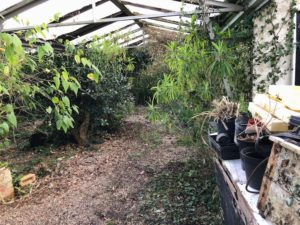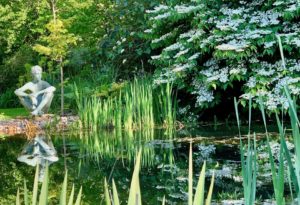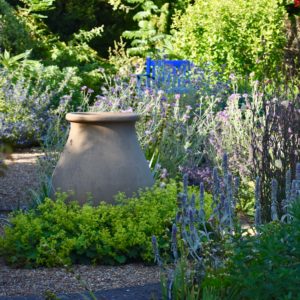Unforgettable Garden of the Month nominated by Virginia Hinze, Sussex Gardens Trust
Created between 1947 and 1985 by Joyce Robinson and John Brookes MBE
Listed Grade II
Denmans was added to Historic England’s Register of Parks and Gardens of Special Historic Interest at grade II in August 2020, as part of the Garden Trust’s successful campaign to recognise and protect significant post war landscapes. Joyce Robinson (1903-1996) began the garden at Denmans around 1947, soon after she and her husband bought the land for a market garden business. By then, she was already an accomplished, self-taught plantswoman and horticulturalist. From 1980-84, the garden began to be managed by John Brookes (1933-2018), the internationally-renowned landscape designer, who continued to garden at Denmans until his death, making it his home, design studio and teaching base. The garden pioneered abundant, naturalistic planting and gravel gardening, which became widely influential through the work of John Brookes as a designer, teacher and writer.
Unforgettable Denmans Garden

Despite its evolution over time, the garden still reflects the ethos of Robinson’s and Brookes’ work. Both used Denmans for experimental work, such as the innovative naturalistic gravel gardens Mrs Robinson first laid out in the 1970s as part of her ‘hobby’ of gardening (she never worked professionally). She described her style of gardening as ‘glorious disarray’, the title she used for her 1989 book about Denmans.
Brookes had also, from the 1960s, been using gravel in his London gardens to address maintenance and poor grass establishment. He discovered Denmans through the NGS open gardens scheme, and Mrs Robinson’s use of gravel and naturalistic planting style both delighted and influenced him. In 1979, after a spell working in Tehran and India, he approached Mrs Robinson, now nearly 80, about moving to Denmans. He went on to live and garden at Denmans for the next 38 years, testing ideas for potential in his design work, unencumbered by clients’ requirements. He set up his Clock House School of Design in the stable block in 1980.
History
In 1946 the Robinsons bought the 34ha Westergate estate at Fontwell, close to the A27 between Arundel and Chichester. The estate had been requisitioned during the war. The following year they sold the manor house and set about renovating the dilapidated gardens, gardener’s cottage and conservatory, transforming them into a productive market garden. Mrs Robinson began ornamental gardening there in the early 1950s, incorporating some plants that she had brought from their previous home. She developed into a knowledgeable plantswoman by visiting local nurseries, botanical gardens and RHS shows at Westminster, and wrote articles for the West Sussex Gazette.

The garden is an oblong of around 1.6ha which falls into two unequal parts separated by Denmans Cottage. The walled garden, to the east of the Cottage, was where Mrs Robinson – or Mrs JH as she was known to everyone – created her first gravel garden in 1970. Convinced that she could recreate the natural landscape of rampant plants and stonework she had fallen in love with on Delos she brought in local gravel and allowed her plants to self-sow and ramble within it, nurturing only those she wanted.
Mrs Robinson extended her garden south of the Cottage, adding to it in 1982 a circular pond which Brookes ‘integrated into the gravel garden that swept from the wall on Denmans Lane across to the Victorian conservatory, with bold, simple, curves’. South-east of the walled garden Mrs Robinson laid out a lawn where grass was left long during the summer to create different textures and to allow flowers to grow.

In 1977 she used a redundant calf paddock to create her two new gravel ‘stream’ beds using sandstone and ironstone rocks from the Rother valley and water-worn gravel from Littlehampton. The dry river hole where the ‘stream’ beds terminated was reinforced by low banks of earth and embellished with a large, flat, water-worn stepping stone set across one to reinforce the illusion. She planted the ‘stream’ beds with grasses, bulbs, irises, thistles, mint, willow, elder and drifts of violets.
Influence of John Brookes
From 1980, while running his School of Design, Brookes revised Denmans’ beds and walks, creating garden rooms and spaces that embraced Mrs. Robinson’s gravel gardens. He introduced additional native and exotic plants and created curved beds and shapes throughout the garden, influenced by Roberto Burle-Marx, the iconic Brazilian landscape architect, artist and ecologist whose work Brookes admired. Much later Brookes referred to his approach of integrating planting with strong architectural and structural elements as one of ‘controlled disarray’.

Brookes spent the rest of his life revising and changing the entire garden. The walled garden went through various iterations after Mrs Robinson’s death, key features now being a brick-outlined circle and square, a series of large, formally shaped boxwood globes and shingle walks throughout. Roses, clematis, Vitex, and other vines and many of Mrs Robinson’s unusual shrubs remain in place. Brookes’ iconic blue timber benches appear here, in the southern lawn area and in the garden north of his home in the Clock House.
He remodelled this latter part as his ‘Room Outside’, the title of his seminal book on garden design published in 1969. The design, which featured frequently in Brookes’ writing, was influenced by the work of the artist Piet Mondrian. It again uses gravel, with displays of a wide variety of sculpture. At some point birches and a Pteracarya fraxinifolia were added to the surviving orchard trees. The pergola Brookes installed in the 1980s, which was taken down in the early 2000s, will be restored in 2021.
Current status
A partnership with businessman Michael Neve from around 1984 developed Denmans as a visitor attraction. This eventually failed putting the garden at risk of damage or even loss. The partnership was liquidated in 2017 and Denmans was rescued with assistance from Peter Gillespie and Gwendolyn van Paasschen. She purchased the garden the same year and began restoring it with Mr. Brookes until his death in March 2018, setting up the John Brookes-Denmans Foundation. The restoration will continue for some years to come and research about the development of the garden is ongoing.
Photos © Denmans Garden
Further reading
The Denmans Garden website has more information about the history and restoration of the garden, as well as opening details.
The entry for Denmans on the Historic England register, including information about the career and influence of John Brookes.
Joyce Robinson, Glorious Disarray, Michael Joseph, 1989
John Brookes MBE, A Landscape Legacy, Pimpernel Press, 2018
Barbara Simms, John Brookes, Garden and Landscape Designer, Conran Octopus, 2007
Find out more about our campaign to highlight the many unforgettable gardens we all treasure.


